Part one of this route covered the eastern section of Scotland, and now in part two we’ll look at the west. It also covers the whole period of the Jacobite risings, from the 1689 attempt to put King James VII and II back on the throne to the final, tragic days of his grandson Bonnie Prince Charlie’s rising in 1746. As mentioned in Part 1, membership of both the National Trust for Scotland and Historic Environment Scotland is recommended if you want to visit the buildings mentioned – it will cost far less than individual tickets.
Before getting started, have a quick look over our very own map of the Jacobite Trail route below, taking you from Edinburgh to Brodie Castle in the north, and back down the western coast of Scotland;
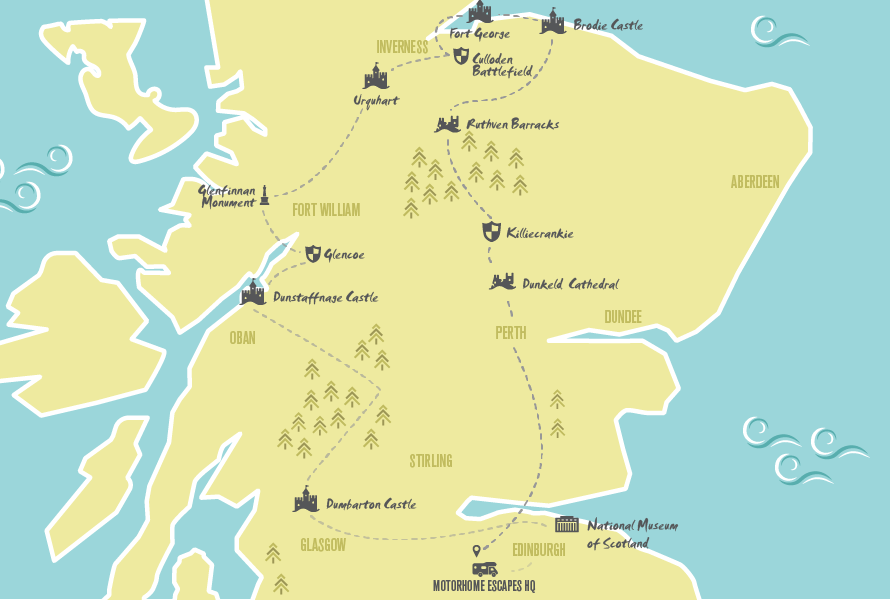
Dunkeld’s Ruined Cathedral and Killiecrankie’s Battle Site
It’s not necessary to complete part one of our Jacobite Trail before you can do Part two. In fact, we designed these routes so that both start off in Edinburgh, making it easy for you to pick up your motorhome from Motorhome Escapes HQ, and start your adventuring!
Our tour of Western Scotland’s Jacobite sites kicks off with a journey north from Edinburgh to Perth via the M90, and onwards up the A9 to Dunkeld. The Jacobites fought a battle here in 1689, a 16-hour marathon, which they eventually lost through sheer exhaustion. Dunkeld’s ruined Cathedral is definitely worth visiting for the stunning surroundings, and the town is also famous for its traditional music and pubs (the two are connected!).
A little further up the A9 is Killiecrankie (PH16 5LG), a stunning wooded gorge which is now a conservation area. Pop into the visitor centre to learn more about the history of the area. You’re going backwards in Jacobite history here: the Battle of Killiecrankie preceded that of Dunkeld by about a month.
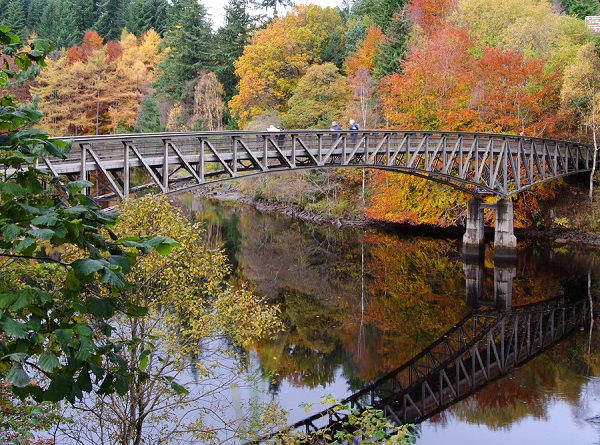
Killiecrankie is a lovely spot these days, a fine area of woodland with the River Garry running through it, but it’s a narrow pass and a good strategic place for a battle. The Jacobites won this time, and there’s a narrow section of the river known as the Soldier’s Leap, which one of the redcoats (the government army) jumped to escape from the ferocious Highlanders.
Robert Burns wrote a song about the battle, in which the famous general Bonnie Dundee (John Graham, 1st Marquis of Claverhouse) died. Today, the wildlife have the place to themselves (apart from the visitors) and thrive; the visitor centre can tell you about both the battle and the wildlife.
On up the road a bit, take the B847 turn-off for a brief visit to Kinloch Rannoch, a quintessentially Scottish area which will just take your breath away. This is where Claire and Frank enjoyed a second honeymoon in Season 1 of Outlander; perfect for a picnic!
Ruthven Barracks at the Head of the Spey Valley
Return to the A9, and about half an hour further west you pass Dalwhinnie Distillery, one of the most exposed distilleries in mainland Scotland. A little father on along the A86, you’ll also encounter the Highland Folk Museum in Newtonmore; Britain’s first open air museum with a 1700s township and working croft available to explore. This little gem featured briefly in Season 1 of Outlander, and is well worth a visit to learn how Scottish Highlanders truly lived. Drive on up the A9 for another 20 minutes before turning right on the B970 for Ruthven Barracks (PH21 1NR; the left turn would take you to Kingussie).
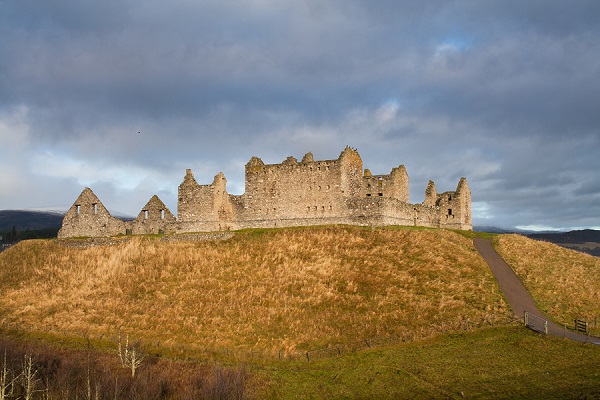
Ruthven Barracks was built in 1719, after the 1715 Jacobite Rising (the ’15) in favour of the Old Pretender, Bonnie Prince Charlie’s father James. It saw action twice during the 1745 rising (the ’45): it was unsuccessfully attacked in 1745 and surrendered to the Jacobites in 1746. The survivors mustered here after the Battle of Culloden (the last ever pitched battle on British soil) before admitting their defeat and scattering.
Like Corgarff Castle, which is covered in Part 1 of this guide, Ruthven is in a very exposed position on a large mound with views right across the country. It must have made uncomfortable living quarters for the soldiers but was ideal for keeping a lookout for stray Jacobites.
Brodie Castle and Fort George along The Moray Firth
For the next site, Brodie Castle (IV36 2TE) you have several possible routes. Two are over the hills; if you don’t fancy twisty roads or the weather’s bad, take the A9 all the way North to Inverness and then follow the A96 east along the coast to Forres.
For a more scenic journey, turn right off the A9 to Carrbridge (after passing through Kinveachy). If you have children with you, the nearby Landmark Forest Adventure Park will give them (and you) a chance to let off steam. From Carrbridge, your first option is to take the A938 east and then turn left on the B9007/A940 which takes you straight north (or as straight as a hill road can) to Forres.
If you’re a whisky lover, you might prefer instead to go a little further along the A938/A95/B9102 (bypassing the left turn onto the B9007/A940) for a brief stop at Grantown-on-Spey, the world’s greatest malt whisky producing region, past the Craggan Football, Frisbee and Golf Course (playing all three at once is not obligatory…). From Grantown, the Old Military Road (built to help the Government suppress Jacobites) A939/A940 takes you onward and north to Forres.
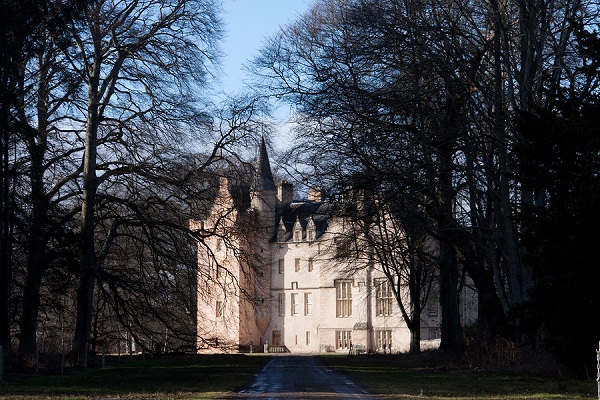
Brodie Castle is an imposing white, turreted and crow-stepped-gabled building, home of the Brodie family since before the time of Robert the Bruce. They were on the Government’s side during the Jacobite period and the redcoats camped in a wood behind the castle. The gardens are spectacular, especially in spring, and the house has parts dating from the 16th, 17th and 19th centuries.
From Brodie, head westwards on the A96 to Fort George, a star-shaped fortress on the windy shores of the Moray Firth. It’s one of Britain’s most redoubtable strongholds and was built after the Battle of Culloden to prevent any resurgence of rebel action. It has been in active service for nearly 250 years: it’s still a working barracks as well as a visitor attraction.
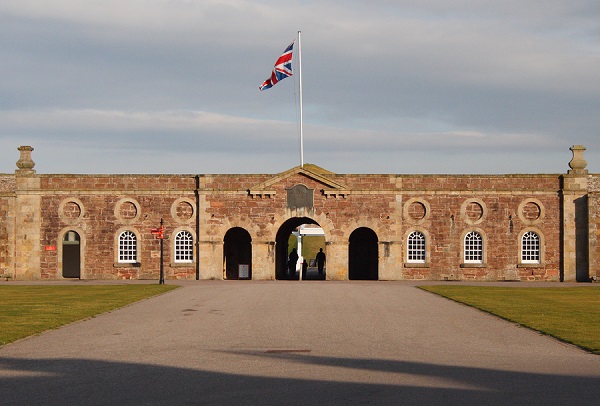
Fort George has lots of spaces to poke your nose into, a fascinating museum, miles of ramparts to walk along, an excellent café – and a resident pod of dolphins in the Moray Firth to watch out for. It’s right next to the beach too, so you can leave your car in the car park and take a walk along the Firth after your visit.
Culloden Battlefield and Interactive Visitor Centre
Culloden, site of the last major battle on British soil, is just along the road and more inland, between Fort George and Inverness. This is the place where, on April 16th 1746, the Jacobites’ final hope of putting the Stuarts back on the British throne died, along with over 1,200 Jacobite soldiers, in just an hour.
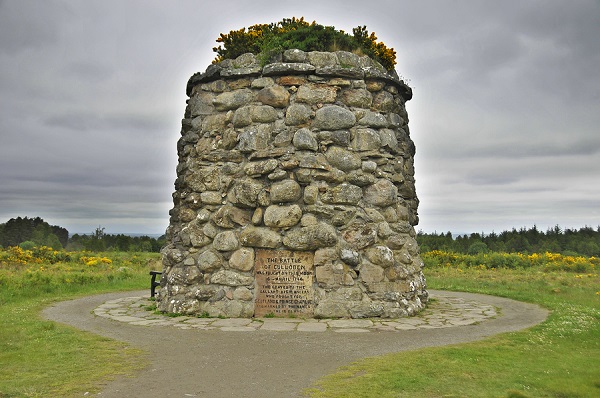
The National Trust for Scotland runs the award-winning visitor centre, with interactive displays, artefacts from soldiers on both sides, and an immersive theatre where you can experience how it felt to be involved in the battle. You can wander around Culloden Moor and see the cottage where many wounded Jacobites, who had taken refuge there, were killed by Government soldiers.
The NTS also runs Living History days from time to time (check their website for details), so you could find yourselves being kitted up as a Highlander or redcoat or even watching a live re-enactment of the Battle.
Urquhart Castle on The Great Glen
The next stop is Urquhart (pronounced Urkert) Castle (IV63 6XJ) on the shores of Loch Ness. To get to it, head through Inverness and then south on the A82 alongside the western edge of Loch Ness; remember to keep your eyes peeled for Nessie, the legendary Loch Ness Monster!

Urquhart has a 1,000-year history. It’s strategically placed on a promontory above the water, with views right up and down the loch. You can climb to the top of the tower to enjoy the full panorama, peer down into the gloomy dungeons and wander round the ancient Great Hall.
The castle was involved in the first Jacobite rising, in 1689. Government soldiers were stationed here 1689-92 and blew up the gatehouse as they left so that the castle would be no use to the Jacobites afterwards. It’s a splendid ruin on a splendid site and very photogenic – whichever way you turn there’s a great picture beckoning.
The Harry Potter Sites of Glenfinnan and Glencoe
Follow the A82 down from Loch Ness straight to Fort William and take the Road to the Isles (A830) west to Glenfinnan. Harry Potter fans can see the famous Hogwarts Express train which follows the road, with the famous railway viaduct appearing north of Glenfinnan across the River Finnan (the trip from Glasgow and Fort William to Mallaig is one of the world’s great train journeys). Whilst driving through Glenfinnan, you’ll pass Loch Shiel to the south, which was used as Hogwarts Lake a few times, and the island was where the Tri-Wizard Tournament was held.
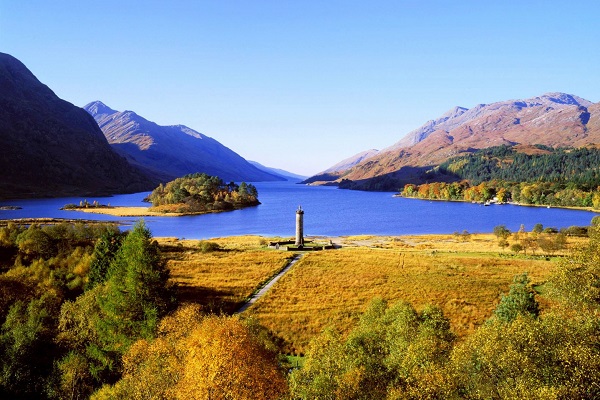
Nearby is Bonnie Prince Charlie’s cave, where he hid after the defeat at Culloden. And one of the best campsites in Scotland is a little further up the road, at Arisaig. But none of these are part of the Jacobite Trail.
The reason you’re here is the Glenfinnan Monument (PH37 4LT) on the shores of Loch Shiel, built where Bonnie Prince Charlie raised his standard on 19th August 1745 and “set the heather alight”. The column is 18 metres high. On top is a lone Highlander, representing all the men who fought and, in many cases, died to put “the man who was born to be king” back on the throne. Climb to the top to admire the views of Loch Shiel and the surrounding country; it really is worth the effort.
Your next stop is one of the eeriest place in Scotland, scene of massacre and treachery: Glencoe (PH49 4HX). Your route takes you back east to Fort William and then south along the A82 to Ballachulish. Cross the bridge over Loch Leven and turn east on the A82 to reach the glen, enclosed by towering hills, where 38 members of the MacDonald clan, supporters of the Old Pretender in the 1689 rising, were slaughtered by government troops who had enjoyed their hospitality.
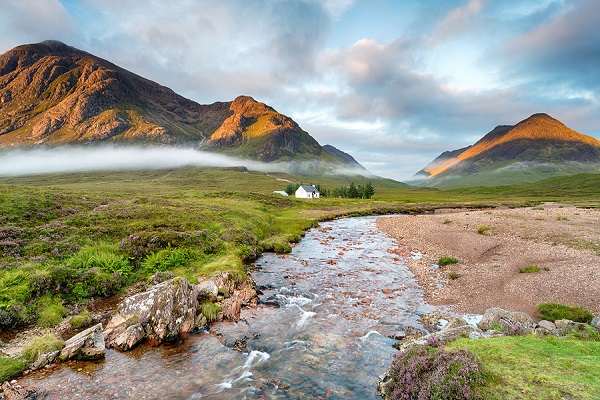
There’s an excellent Glencoe visitor centre, and you can take a ranger-led walk or Land Rover safari into the hills – because, of course, there’s much more to Glencoe than a 325-year-old massacre. It’s a popular walking and skiing area with abundant wildlife; there just aren’t many human residents.
And for the Outlander fans, Glencoe may be familiar from the opening credits of season 1, with it’s epic mountain peaks, rivers and waterfalls.
Heading South for Dunstaffnage Castle and Dumbarton Castle
From Glencoe, go back west along the A82 to Ballachulish before following the road south along a spectacularly beautiful stretch of coast to Dunstaffnage Castle (PA37 1PZ), at the entrance to Loch Etive, just north of Oban and Dunbeg. It dates from the 13th century and protected the fjord-like loch, and those who live along its banks, from marauders.
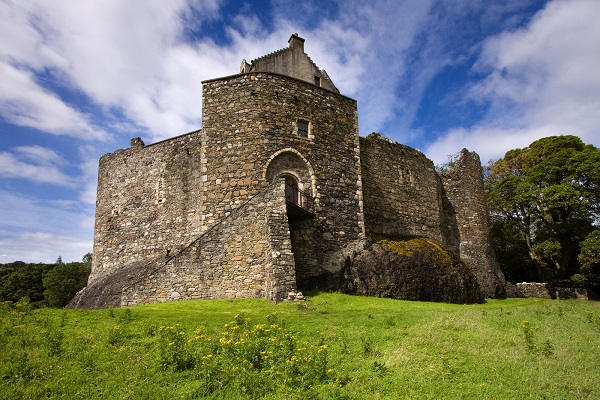
Nowadays Dunstaffnage is most famous as the place where Flora MacDonald was imprisoned after she helped Bonnie Prince Charlie escape to France by taking him to Skye from the Outer Hebrides, dressed as her maid. The castle is still very solid, despite being a ruin, and you can feel its power as you enter the gateway. There’s also a chapel in the woods – again, ruined, but still beautiful and worth the short walk to find it.
From Dunstaffnage head inland and east along the A82 to Crianlarich, then take the Glasgow road (A82) south along the bonnie banks of Loch Lomond to Dumbarton Castle (G82 1JJ). Dumbarton Rock looms over the countryside and the River Clyde, and the castle takes full advantage of its position on the Rock.
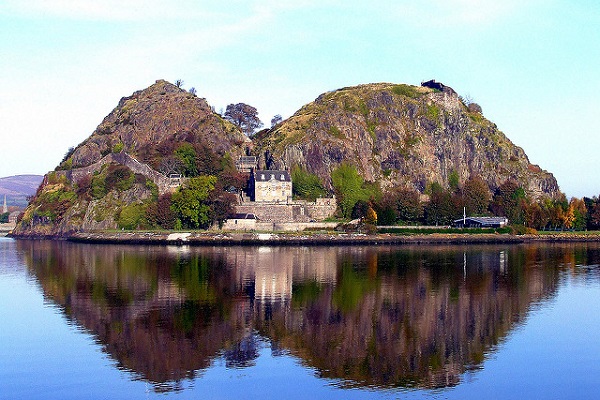
The castle was a government garrison during the ’45 and one of the so-called seven men of Moidart, who helped bring Bonnie Prince Charlie to Scotland, was imprisoned here after Culloden. The Governor’s House dates from around this time and is full of artefacts found in the castle. If you’re feeling energetic, climb the White Crag behind the castle for views across half of southern Scotland (or that’s what it feels like on a clear day!).
Coming to a close in Edinburgh
There’s just one more stop on your Jacobite itinerary, and you have to get past Glasgow (via the A82) and along the M8 to Edinburgh for it. It’s wise to leave your motorhome in one of the official Edinburgh Park and Ride areas on the outskirts of the city and take the bus or (from the one at Ingliston) the tram into the city centre.
The National Museum of Scotland is at Chambers Street (EH1 1JF) and gives you a run-down of Scottish history from the days before the Viking invasions. They have a large collection of Jacobite items, including a ring belonging to James VII and II, the Old Pretender’s sword, Bonnie Prince Charlie’s canteen and a targe (shield) given to him before the Battle of Culloden.
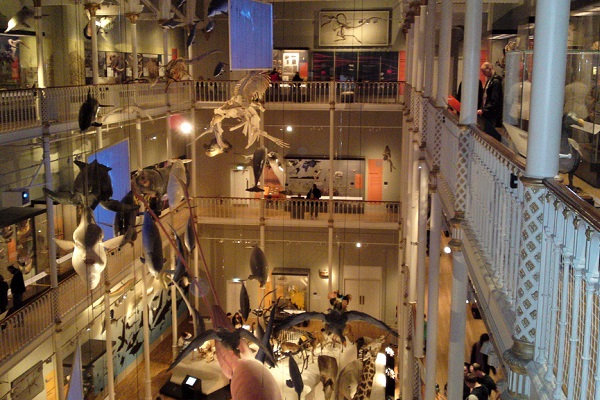
The Museum has military uniforms and regimental colours from both sides of the conflict, and a portrait of “Butcher” Cumberland, the general who won the Battle of Culloden and made sure the Jacobites would never rise again by killing as many as he could find, not just at the battle field but all over the country afterwards.
The Museum’s collection sums up the whole tragic story of the later Stuarts and their supporters and enemies, and makes a fitting end to the Jacobite Trail.
Finish off your motorhome hire Scotland with a wander through Edinburgh’s historic streets before returning to the Park and Ride, and dropping your vehicle off at Motorhome Escapes HQ. You’ll leave Scotland full to the brim with Jacobite knowledge and a real sense of what it was like back in those turbulent days.
For help planning your trip, with recommendations on non-history-related attractions as well, just get in touch with us via the contact page and we’d be happy to chat! Or to squeeze in even more Jacobite and Outlander related adventures, check out part one of our Jacobite trail, and merge it with part two!
Happy motorhoming!